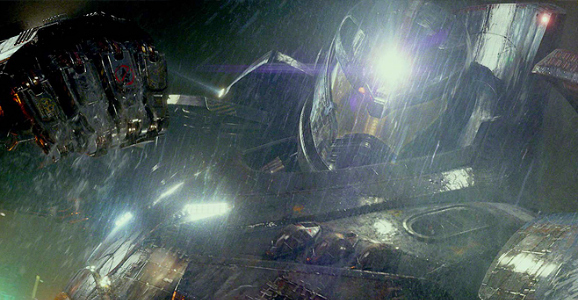Gipsy Danger’s Elbow Rocket Is Like A 747 To A Kaiju’s Face
This article is more than 2 years old
 Guillermo del Toro’s Pacific Rim came out swinging when it was released a few weeks ago, but general audiences were more eager to watch the latest Adam Sandler rehash (Grown Ups 2) or adorable little animated guys they’ve already seen (Despicable Me 2). While Pacific Rim has been box office disappointment with a $78.6 million domestic gross, that hasn’t deterred genre fans for proclaiming del Toro’s film as one of the best movies of the year. It’s clear that Pacific Rim has a fan base made up of geeks, but strangely enough, some of its most vocal fans are scientists, and not even the crazy ones played by Charlie Day and Burn Gorman in the film.
Guillermo del Toro’s Pacific Rim came out swinging when it was released a few weeks ago, but general audiences were more eager to watch the latest Adam Sandler rehash (Grown Ups 2) or adorable little animated guys they’ve already seen (Despicable Me 2). While Pacific Rim has been box office disappointment with a $78.6 million domestic gross, that hasn’t deterred genre fans for proclaiming del Toro’s film as one of the best movies of the year. It’s clear that Pacific Rim has a fan base made up of geeks, but strangely enough, some of its most vocal fans are scientists, and not even the crazy ones played by Charlie Day and Burn Gorman in the film.
The writers at Scientific America examined the physics behind a fight between an actual giant robot and real-life massive monster. Obviously, they made the assumption that the world of Pacific Rim actually exists, and the film is a documentary, rather than a fictional narrative. They took a look at the battle between Gipsy Danger and Kaiju codenamed Leatherback, specifically focusing on the moment when Gipsy Danger uses a rocket elbow to knockout the giant creature.
The scientists estimate that Gipsy Danger weighs approximately 7,080 tons and the arm delivering the knockout punch weighs about 1.5 million pounds. They say the force of the rocket punch is equivalent to a Boeing 747 going 60 miles per hour, as it carries about 125,000,000 Joules of kinetic energy directly at the Kaiju’s face. Now that’s power. They note that the rocket punch would also generate a similar amount of force as a Saturn V rocket, which means the Jaeger could theoretically throw an object at the weight of one-kilogram directly into out space.
Needless to say, this is one badass machine. Considering that Gipsy Danger isn’t even the most powerful Jaeger in the Pan Pacific Defense Corps, its rocket punch sure packs a mighty wallop. Just think about the power behind the Australian Striker Eureka, or China’s three-armed Crimson Typhoon.
The article also looks at the nuclear explosions at the bottom of the ocean in the film’s climax. They wanted to know exactly how big an explosion would have to be in order to turn the Pacific Ocean into a vacuum before the water came pouring back in. There were two nuclear explosions at the end of Pacific Rim, one from Striker Eureka, and the other from Gipsy Danger. To make that kind of damage happen at the bottom of the ocean, Striker Eureka had to have been out fitted with a 2,400-pound thermonuclear device. That is equivalent to 1.2 million tons of TNT. This initial explosion would’ve created a large bubble, which is why the seafloor went dry for a moment.
They estimate that the final battle scene at the end of Pacific Rim happened somewhere in the part of the ocean that is known as The Abyss. This region is roughly 4,000 meters, or about 2.5 miles, beneath the ocean’s surface. At that depth, the nuclear explosion would’ve created a bubble, while at the same time, nothing above of the ocean surface would be effected. The blast would’ve had a top speed of about 200 miles per hour to create those conditions.
I highly recommend taking a look at the entire two-part article on the science and physics of Pacific Rim at Scientific America. It’s an eye opening to read about the true scale, and real world science behind the Jaegers and Kaiju.












